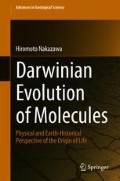Abstract
To approach the origin of life, the physical inevitability of generation and evolution of life is the fundamental issue that must be first addressed. The question “Why did life generate?” asks essentially the same question as “Why does life evolve?” since it demands a physical reason for the organization of organic molecules to higher complexity in the dynamic environment on Earth. As reviewed in Chapter 1, Earth has been radiating heat to space for the 4.6 billion years since its formation. This indicates from the view of the second law of thermodynamics that the decrease of Earth’s entropy due to radiation of heat is the cause of life’s instigation and its evolution to the present biodiversity.
Access this chapter
Tax calculation will be finalised at checkout
Purchases are for personal use only
Notes
- 1.
When a high-temperature object (T1) is placed in contact with a low-temperature object (T2), heat flows from the high-temperature object to the low-temperature object, until both objects reach the same temperature. If heat flow is ∆Q, the entropy of the low-temperature object increases ∆Q/T2 while that of the high-temperature object decreases ∆Q/T1. The total entropy change ∆S of this “universe,” i.e., the total entropy change of an isolated system is defined as ∆S = ∆Q/T2 −∆Q/T1. Since T2 < T1, the total entropy change (∆S) of the isolated system (“the universe”) is always positive; i.e., it increases during heat flow from a high-temperature object to a low-temperature object.
- 2.
Entropy (S) is given by the expression S = klogW, where k is the Boltzmann constant, k = 1.3806488 × 1023 J/K, and W is the number of states of microparticles. Since the unit of k is J/K, “the amount of heat (Joule)/temperature (K),” it is also involved in macroscopic quantities, such as temperature, heat, and specific heat. Therefore, k is an important constant that connects the macroscopic and micro-particulate realms. The epitaph on the tomb of L. Boltzmann in Vienna, Austria, reads simply “S = klogW” in concise recognition of his most significant achievement.
References
Anglada-Escude G, Amado PJ, Barnes J, Berdinas ZM, Butler RP, Coleman GA., de la Cueva I, Dreizler S, Endl M, Giesers B, Jeffers SV, Jenkins JS, Jones HRA, Kiraga M, Kürster M, Lopez-Gonzalez MJ, Marvin CJ, Morales N, Morin J, Nelson RP, Ortiz JL, Ofir A, Paardekooper S, Reiners A, Rodrigues E, Rodrigues-Lopez C, Samiernto LF, Strachan JP, Tsapras Y, Sechneiuster TM (2016) A terrestrial planet candidate in a template orbit around Proxima Centaui, Nature 536:437–440
Ida S (2003) Variant of the planet, from a formation theory of extrasolar planet (in Japanese). NHK Books, Tokyo, p 227
Ijiri S (1968) Kaseki (in Japanese, Fossils), Iwanami-Shinsho vol 673. Tokyo, pp 66–79
Nomura R, Hirose K, Uesugi K, Ohishi Y, Tsuchiyama A, Miyake A, Ueno Y (2014) Low core-mantle boundary temperature inferred from the solidus of pyrolite. Science 343:522–525
Schrödinger E (1944) What is life?—The physical aspect of the living cell. Cambridge University Press, London
Tajika E (1996) The Chapter 2, Construction of the earth, in Introduction to Earth and planetary science (in Japanese). Iwanamishoten, Tokyo, pp 92 and 96
The KamLAND Collaboration (2011) Partial radiogenic heat model for Earth revealed by geonutrino measurements. Nat Geosci 4:647–651. Online Publication 17 July 2011
Witze A (2016) Nearby star hosts planet. Nature 536:381–382
Author information
Authors and Affiliations
Corresponding author
Rights and permissions
Copyright information
© 2018 Springer Nature Singapore Pte Ltd.
About this chapter
Cite this chapter
Nakazawa, H. (2018). Why Did Life Generate? Why Does Life Evolve? Physical Perspective of the Origin of Life. In: Darwinian Evolution of Molecules. Advances in Geological Science. Springer, Singapore. https://doi.org/10.1007/978-981-10-8724-0_2
Download citation
DOI: https://doi.org/10.1007/978-981-10-8724-0_2
Published:
Publisher Name: Springer, Singapore
Print ISBN: 978-981-10-8723-3
Online ISBN: 978-981-10-8724-0
eBook Packages: Earth and Environmental ScienceEarth and Environmental Science (R0)

